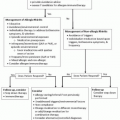Name/Products |
Indications/Mechanisms |
Potential Adverse Effects |
Therapeutic Issues |
Corticosteroids
Inhaled (ICS):
Beclomethasone dipropionate
Budesonide
Ciclesonide
Flunisolide
Fluticasone propionate
Mometasone furoate
Triamcinolone acetonide |
Indications
Long-term prevention of symptoms; suppression, control, and reversal of inflammation
Reduce need for oral steroid
Mechanisms
Block late reaction to allergen and reduce BHR
Inhibit cytokine production, adhesion protein activation, and inflammatory cell migration and activation
Reverse beta2 receptor downregulation Inhibit microvascular leakage |
Cough, dysphonia, oral thrush
In high doses, systemic effects may occur (e.g., adrenal suppression, osteoporosis, skin thinning, easy bruising).
In low to medium doses, suppression of growth velocity in children, but this effect might be transient (clinical significance has not been established). |
Spacer/holding chamber devices with nonbreath-activated MDIs and mouth washing after inhalation decrease local side effects.
Preparations not absolutely interchangeable on a mcg or per puff basis
Risks of uncontrolled asthma should be weighed against the limited risks of ICS therapy.
“Adjustable dose” approach to treatment may enable reduction in cumulative dose of ICS treatment over time without sacrificing maintenance of asthma control.
Dexamethasone is not included as an ICS for long-term control because it is highly absorbed and has long-term suppressive side effects. |
Systemic:
Methylprednisolone
Prednisolone
Prednisone |
Indications
Short-term (3-10 d) “burst”: to gain prompt control of inadequately controlled persistent asthma
Long-term prevention of symptoms in severe persistent asthma: suppression, control, and reversal of inflammation
Mechanisms
Same as inhaled |
Short-term use: reversible abnormalities in glucose metabolism, increased appetite, fluid retention, weight gain, mood alteration, hypertension, peptic ulcer, and rarely aseptic necrosis
Long-term use: adrenal axis suppression, growth suppression, dermal thinning, hypertension, diabetes, Cushing’s syndrome, cataracts, muscle weakness, and—in rare instances—impaired immune function
Consideration should be given to coexisting conditions that could be worsened. |
Use at lowest effective dose. For long-term use, alternate-day am dosing produces the least toxicity. |
Immunomodulators
Omalizumab (anti-IgE) for subcutaneous use |
Indications
Long-term control and prevention of symptoms in adults (≥12 y) with moderate to severe persistent allergic asthma inadequately controlled on ICS
Mechanisms
Binds circulating IgE preventing it from binding to FcεR1 receptors on basophils and mast cells
Decreases mast cell mediator release from allergen exposure
Decreases the number of Fc ε R1s in basophils and submucosal cells |
Pain and bruising of injection sites in 15%-20% of patients
Anaphylaxis reported
Malignant neoplasms reported in 0.5% of patients compared to 0.2% receiving placebo; relationship to drug is unclear. |
Monitor patients following injection. Be prepared to identify and treat anaphylaxis that may occur.
Dose is administered every 2-4 wk and is dependent on body weight and IgE level before therapy.
A maximum of 150 mg can be given in one injection.
Needs to be stored under refrigeration at 2°C-8°C
Whether patients will develop significant antibody titers with long-term use is unknown. |
Leukotriene receptor antagonists (LTRAs) |
Mechanisms
Selective competitive inhibitor of CysLT1 receptor |
|
May attenuate EIB in some patients
Do not use LTRA + LABA as a substitute for ICS + LABA. |
Montelukast tablets and granules |
Indications
Long-term control and prevention of symptoms in mild persistent asthma for patients ≥1 y. May be used in combination with ICS as combination therapy in moderate persistent asthma |
No specific adverse effects have been identified
Rare cases of Churg-Strauss have occurred but the association is unclear |
A flat dose-response curve, without further benefit, if dose is increased above those recommended
Administration with meals decreases bioavailability; take at least 1 h before or 2 h after meals.
Zafirlukast is a microsomal P450 inhibitor that can inhibit metabolism of warfarin. Monitor INR during administration.
Patients should be warned to discontinue if they experience signs and symptoms of liver dysfunction, and patients’ LFTs should be monitored. |
Zafirlukast tablets |
Indications
Long-term control and prevention of symptoms in mild persistent asthma for patients ≥7 y. May also be used with ICS as combination therapy in moderate persistent asthma |
Postmarketing surveillance has reported cases of reversible hepatitis and, rarely, irreversible hepatic failure resulting in death and liver transplant. |
5-Lipoxygenase inhibitor
Zileuton tablets |
Mechanisms
Inhibits the production of LTs from arachidonic acid, both LTB4 and the cysteinyl leukotrienes
Indications
Long-term control and prevention of symptoms in mild persistent asthma for patients ≥12 y
May be used with ICS as combination therapy in moderate persistent asthma |
Elevation of liver enzymes reported. Limited case reports of reversible hepatitis and hyperbilirubinemia |
Microsomal P450 inhibitor that can inhibit the metabolism of warfarin and theophylline.
Monitor hepatic enzymes (ALT). |
Long-acting beta2-agonists (LABAs)
Inhaled LABA:
Formoterol
Salmeterol
Oral:
Albuterol, sustained-release |
Indications
Long-term prevention of symptoms, added to ICS
Prevention of EIB
Not to be used to treat acute symptoms or exacerbations.
Mechanisms
Smooth muscle relaxation following adenylate cyclase activation and increase in cyclic AMP, producing function antagonism of bronchoconstriction
Compared to SABA, salmeterol (but not formoterol) has a slower onset of action. Both salmeterol and formoterol have longer duration of action (>12 h) compared to SABA. |
Tachycardia, skeletal muscle tremor, hypokalemia, QTc prolongation in overdose
A diminished bronchoprotective effect may occur within 1 wk of chronic therapy. Clinical significance has not been established.
Potential risk of uncommon, severe, life-threatening or fatal exacerbation |
Not to be used to treat acute symptoms or exacerbations
Should not be used as monotherapy for long-term control of asthma or as anti-inflammatory therapy
May provide more effective symptom control when added to standard doses of ICS compared to increasing ICS dosage
Clinical significance of potentially developing tolerance is uncertain.
Decreased duration of protection against EIB may occur with regular use.
Inhaled route preferred because LABAs are longer acting and have fewer side effects than oral sustained-release agents. |
Methylxanthines
Theophylline, sustained-release tablets and capsules |
Indications
Long-term control and prevention of symptoms in mild persistent asthma or as adjunctive with ICS in moderate or persistent asthma
Mechanisms
Smooth muscle relaxation from phosphodiesterase inhibition and possibly adenosine antagonism
May affect eosinophilic infiltration into bronchial mucosa as well as decreases T cell numbers in epithelium
Increases diaphragm contractility and mucociliary clearance |
Dose-related acute toxicities include tachycardia, nausea and vomiting, tachyarrhythmias (SVT), CNS stimulation, headache, seizures, hematemesis, hyperglycemia, and hypokalemia.
Adverse effects at usual therapeutic doses include insomnia, gastric upset, aggravation of ulcer or reflux, increase in hyperactivity in some children, and difficulty in urination in elderly males who have prostatism. |
Maintain steady-state serum concentrations between 5 and 15 µg/mL. Routine serum concentration monitoring is essential due to significant toxicities, narrow therapeutic window, and individual differences in clearance.
Patients should be told to discontinue if they experience toxicity.
Not generally recommended for exacerbations. There is minimal evidence for added benefit to optimal doses of SABA. |
Quick-relief medications |
Short-acting beta2-agonists (SABAs)
Inhaled SABA:
Albuterol
Levalbuterol
Pirbuterol |
Indications
Relief of acute symptoms
Preventative treatment for EIB prior to exercise
Mechanisms
Binds to beta-2 adrenergic receptor, producing smooth muscle relaxation following adenylate cyclase activation and increase in cyclic AMP producing functional antagonism of bronchoconstriction |
Tachycardia, skeletal muscle tremor, hypokalemia, increased lactic acid, headache, and hyperglycemia. Inhaled route, in general, causes few systemic adverse effects.
Patients with preexisting cardiovascular disease, especially the elderly, may have adverse cardiovascular reactions with inhaled therapy. |
Drugs of choice for acute bronchospasm. Inhaled route has faster onset, fewer adverse effects, and is more effective than systemic routes. Oral systemic beta2-agonists are not recommended.
For patients who have intermittent asthma, regularly scheduled daily use neither harms nor benefits asthma control. Regularly scheduled daily use is not recommended.
Regular use >2 d/wk for symptoms control (not EIB prevention), increasing use, or lack of expected effect indicates inadequate control
For patients frequently using SABA, anti-inflammatory medication should be initiated or intensified.
Levalbuterol at one-half the mcg dose produces clinically comparable bronchodilation and systemic side effects as racemic albuterol. |
(Adapted from National Heart, Blood, and Lung Institute Expert Panel Report 3 (EPR 3): Guidelines for the Diagnosis and Management of Asthma. NIH Publication no. 08-4051, 2007.) |







